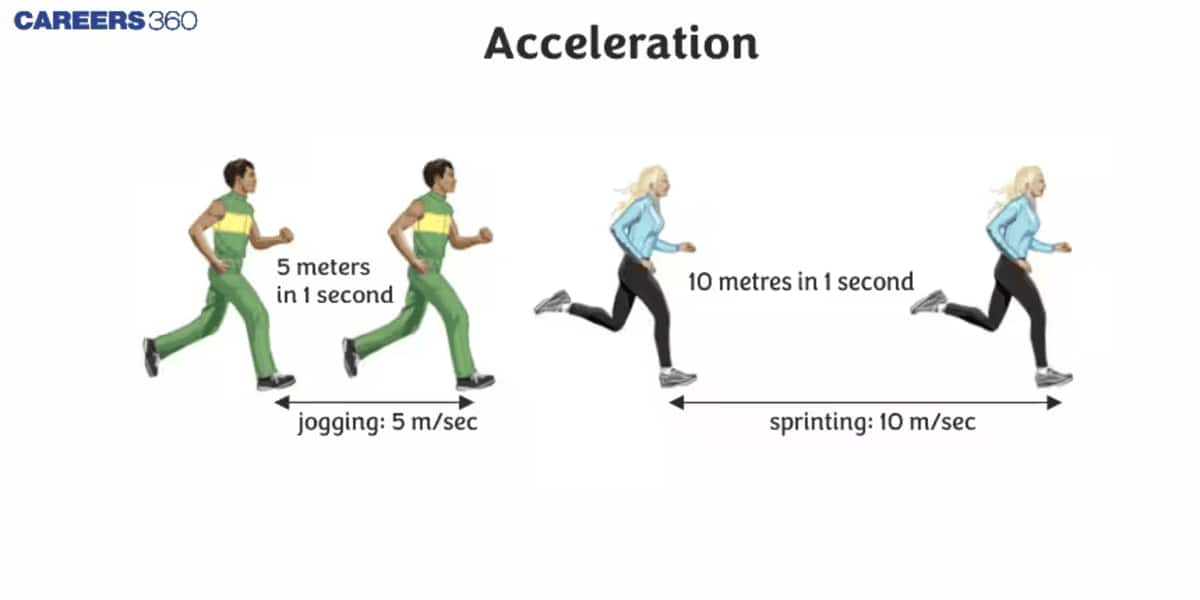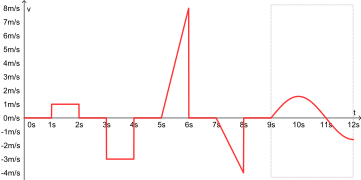Acceleration - Examples, Meaning, Types, Formula, Faqs
Acceleration tells us how much the velocity of an object changes in each unit of time. If velocity changes equally in every second the object has constant acceleration and the motion is called uniformly accelerated motion. If the change is not the same every second the object has variable acceleration also called non-uniformly accelerated motion. It is an important topic for board exams and competitive exams like JEE Main, NEET, BITSAT, SRMJEE, and others. Learning acceleration is very important because it forms the base for topics like Newton’s laws, force and motion, SHM, gravitation, electromagnetism, and even modern physics.
This Story also Contains
- What is Acceleration?
- Characteristics Of Acceleration
- What Is the Acceleration Formula?
- Important Terms and Equations Related To Acceleration
- Types of Acceleration
- Positive, Negative, And Zero Acceleration
- Real-life Examples Of Acceleration
- Solved Examples Based on Acceleration

What is Acceleration?
Acceleration is defined as the rate of change of velocity with respect to time. It tells us how quickly an object speeds up, slows down, or changes direction. Acceleration is a vector quantity because it has both magnitude and direction. It can also be expressed in terms of calculus: acceleration is the first derivative of velocity with respect to time, or the second derivative of position with respect to time.
Characteristics Of Acceleration
-
The body is said to have undergone acceleration if there is a change in velocity i.e.,
-
Change in speed
-
Change in direction
-
Change in both
-
-
It is a vector quantity.
-
It has both direction and magnitude.
-
It can either be positive or negative.
-
Dimension of acceleration is $L T^{-2}$
-
Acceleration S.I unit: $m s^{-2}$
What Is the Acceleration Formula?
Acceleration is the rate at which velocity changes with time. The basic formula for acceleration is:
$
a=\frac{v-u}{t}
$
Where:
- $\mathbf{a}=$ acceleration
- $\mathbf{v}=$ final velocity
- $\mathbf{u}=$ initial velocity
- $\mathbf{t}=$ time taken for the change
It can also be written in general form as:
$a=\frac{\Delta v}{\Delta t}$
This formula shows how quickly the velocity of an object increases or decreases.
Also read :
Important Terms and Equations Related To Acceleration
1. Instantaneous acceleration :
It is the acceleration of a body at a certain instant of time.
If $r$ denotes the displacement vector,
$v=\frac{\mathrm{dr}}{\mathrm{dt}}$ denotes velocity
Acceleration is equal to,
$\mathrm{a}=\frac{\mathrm{dv}}{\mathrm{dt}}=\frac{d^2 \mathrm{r}}{d \mathrm{t}^2}$
2. Average Acceleration:
Average acceleration is the ratio of change in velocity in a certain time interval to the time interval. The average acceleration formula is given as:
Average Acceleration $\left(a_{\text {avg }}\right)=\frac{v_f-v_i}{t_f-t_i}$
Where,
- $v_f$ is the final velocity,
- $v_i$ is the initial velocity,
- $t_f$ is the final time,
- $t_i$ is the initial time
3. Acceleration Due To Gravity
The acceleration produced in the motion of a body under the effect of gravity is called acceleration due to gravity. It is denoted by "g".
$g=\frac{G \cdot M}{r^2}$
Where,
- $g$ is the acceleration due to gravity (approximately $9.8 \mathrm{~m} / \mathrm{s}^2$ on Earth's surface),
- $G$ is the universal gravitational constant $\left(6.674 \times 10^{-11} \mathrm{Nm}^2 / \mathrm{kg}^2\right),$
- $M$ is the mass of the Earth (or the celestial body in question),
- $r$ is the radius or distance from the center of the Earth (or celestial body) to the object.
4. Centripetal Acceleration:
It is the acceleration experienced by the object moving in a circular path directed towards the centre of the circular path. The centripetal acceleration formula is:
$a_c=\frac{v^2}{r}$
Where,
- $a_c$ is the centripetal acceleration,
- $v$ is the tangential velocity of the object,
- $r$ is the radius of the circular path.
5. Angular Acceleration:
It is the rate of change of angular velocity over time.
$\alpha=\frac{\Delta \omega}{\Delta t}$
Where,
- $\alpha$ is the angular acceleration,
- $\Delta \omega$ is the change in angular velocity,
- $\Delta t$ is the change in time.
6. Tangential Acceleration
It is the rate of change of tangential velocity of an object in a circular path.
$a_t=\frac{d v}{d t}$
Where,
- $a_t$ is the tangential acceleration,
- $v$ is the tangential velocity,
- $t$ is time.
7. Newton’s Second Law Of Motion And Acceleration
According to Newton’s second law of motion, the rate of change of linear momentum of a body is directly proportional to the external force applied on the body, and this change takes place always in the direction of the applied force. The second law of motion gives a measure of force
$F=m \cdot a$
Where,
- $F$ is the net force acting on the object.
- $m$ is the mass of the object
- $a$ is the acceleration of the object.
Related Topics,
Types of Acceleration
-
Uniform acceleration
-
Non-uniform acceleration
1. Uniform Acceleration
We say an object has uniform acceleration if its speed (velocity) increases at a constant pace. That is, there is no change in the rate of acceleration.
As the name implies, uniformly accelerated motion refers to an object or a body that accelerates at a consistent rate. Constant velocity does not imply constant acceleration. The definition of uniform acceleration is when a body is in motion, and the amount of variation in velocity in equal intervals of time is constant.
Example of Uniform acceleration
For an example of uniform acceleration, consider the motion of a freely falling body, where the body's acceleration is the sole acceleration attributable to gravity. When we plot velocity vs time on a graph, we get a straight line, and the entire slope equals the required acceleration. Real-life example would be when someone is parachute diving.

2. Non-Uniform Acceleration
Non-uniform acceleration occurs when an object's velocity varies in variable amounts during equal time intervals.
The opposite of uniform acceleration is non-uniform acceleration. We know that uniform acceleration indicates that the rate of change in velocity remains constant across time. In a non-uniform acceleration, the change in velocity is not the same. The magnitude of acceleration and the direction of velocity will change over time.
Example of non-uniform acceleration
Imagine driving a car on the road; there is a recurrent increase or decrease in the vehicle's velocity at unequal intervals of time, causing the vehicle to experience non-uniform acceleration.

Positive, Negative, And Zero Acceleration
-
When the velocity of the body increases with time, it experiences positive acceleration. It means the velocity-time graph has a positive slope.
-
When the velocity of a body decreases with time, it experiences negative acceleration. It means the velocity-time graph has a negative slope.
-
When the velocity of a body is constant, or the body is at rest, it experiences zero acceleration. It means the velocity-time graph slope is zero.

Real-life Examples Of Acceleration
-
Driving a car
-
Riding a bicycle
-
Airplane takeoff and landing
-
Amusement park rides
-
Lifts
-
Moving Vehicles
-
Falling objects ( falling under acceleration due to gravity)
Also See,
Solved Examples Based on Acceleration
Example 1: The displacement Vs time graph is given below which of the following conclusions is correct:

1) Velocity is constant
2) Velocity is continuously increasing
3) Acceleration is positive
4) Acceleration is negative
Solution :
As we know the slope of the displacement-time graph gives us velocity. Hence, a change in slope represents a change in velocity.
In the above figure, the velocity of the particle i.e. slope in the displacement vs time graph is decreasing.
Therefore, acceleration is negative.
Hence, the answer is option (4).
Example 2: Three position Vs time graph is shown in the figure. In which case acceleration is zero

1) I
2) II
3) III
4) None of these
Solution:
Zero Acceleration
When the final velocity is equal to the initial velocity.
For: V1 = V2
wherein
When a bus is moving with uniform velocity.
Since velocity is constant in case II hence acceleration = 0
Hence, the answer is option (2).
Example 3: Four velocity time graphs (Namely I, II, III, IV ) are shown in the figure. In which case is the acceleration uniform and positive?

Solution:
As it is clear II has a uniform and positive slope so it indicates uniform and positive acceleration.
Hence, the answer is option (2).
Example 4: The position of particles as a function of time $t$ is given by $x(t)=a t+b t^2-c t^3$ where $\mathrm{a}, \mathrm{b}$, and $\mathrm{c}$ are constants. When the particle attains zero acceleration, then its velocity will be :
1) $a+\frac{b^2}{4 c}$
2) $a+\frac{b^2}{3 c}$
3) $a+\frac{b^2}{c}$
4) $a+\frac{b^2}{2 c}$
Solution :
Given:
$\begin{aligned}
& x(t)=a t+b t^2-c t^3 \\
& v=\frac{d x}{d t}=a+2 b t-3 c t^2 \\
& a=\frac{d v}{d t}=2 b-6 c t \\
& a=0 \Rightarrow t=\frac{2 b}{6 c}=\frac{b}{3 c}
\end{aligned}$
$\begin{aligned}
& \text { So, Velocity at time } t=\frac{b}{3 c} \\
& V=a+2 b \times \frac{b}{3 c}-3 c \times \frac{b^2}{9 c^2} \\
& V=a+\frac{b^2}{3 c}
\end{aligned}$
Hence, the answer is the option (2).
Frequently Asked Questions (FAQs)
An object is said to have zero acceleration if the change in velocity is zero, i.e. the body is at rest or travelling at a uniform velocity. A parked car, for example, or a train running at a steady pace of 90 km/hr.
When moving in a circular track, your direction is constantly changing; hence, velocity changes. Therefore your motion is accelerated.
Acceleration is the rate at which velocity changes with respect to time.
Questions related to
On Question asked by student community
Force applied per unit area is termed as pressure.
Explanation: "Pressure" is defined as the force exerted on a surface divided by the area over which that force is distributed.
Option B is correct .
Other options are incorrect, as acceleration is the rate of change of velocity, gravitation is a force attracting objects towards the Earth, and friction is a force that opposes motion between two surfaces.
Hello,
If Earth were to suddenly stop rotating, the acceleration due to gravity at the North Pole would not change. This is because the centripetal force produced by Earth's rotation does not affect the poles. At the equator, Earth's rotation exerts a centrifugal force that partially reduces the apparent gravity. But at the North Pole, there isn't one such centrifugal force because Earth's axis of rotation passes through the poles, so its acceleration due to gravity is the same as the standard value of about 9.8 m/s² .
Hence, if Earth were to stop rotating altogether, the only places affected would be the ones far away from the poles where without that rotation, the effective gravitational force would increase. At the North Pole though, gravity doesn't.
Correct Answer: It is the distance covered by an object in a unit of time
Solution : The correct option is It is the distance covered by an object in a unit of time.
Speed is the distance travelled by an object per unit of time. It quantifies how quickly or slowly an object moves and is a scalar quantity, meaning it only has magnitude (not direction). If the direction of motion is also considered, it becomes velocity.
Correct Answer: at rest
Solution : The correct option is at rest.
Static equilibrium is the state in which all of the forces acting on an object are balanced, and it is not moving concerning the relative plane. A book at rest on top of a table and a ball left on the ground are two examples of systems in static equilibrium.
Correct Answer: m(1+a/g)
Solution : The correct option is m(1+a/g).
The body's measured mass will increase when the lift ascends with acceleration a.
This is due to the apparent weight gain, resulting from the acceleration. The measured mass will be m(1+a/g), where 'm' is the actual mass, 'a' is the lift's acceleration, and 'g' is the acceleration due to gravity. This effect is a consequence of the equivalence principle in general relativity.